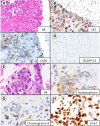Anal canal adenocarcinoma with neuroendocrine features accompanying secondary extramammary Paget disease, successfully treated with modified FOLFOX6: a case report
- PMID: 30458812
- PMCID: PMC6245632
- DOI: 10.1186/s12885-018-5084-0
Anal canal adenocarcinoma with neuroendocrine features accompanying secondary extramammary Paget disease, successfully treated with modified FOLFOX6: a case report
Abstract
Background: Anal canal cancer occasionally accompanies extramammary Paget disease. Although most of them are squamous cell carcinoma, anal canal adenocarcinoma with neuroendocrine features accompanying secondary extramammary Paget disease has never been reported.
Case presentation: Here, we report a 76-year-old man presented with pruritus in the perianal area. Investigation revealed a fist-sized perianal erythema, diffuse liver tumors, and right inguinal lymph node swelling. Pathological examination of biopsies from the erythema suggested secondary extramammary Paget disease with positive cytokeratin-7 and -20 expressions and negative GCDFP-15 expression. The anal canal tumor was confirmed by digital examination and endoscopy. Biopsies from the anal canal tumor, swollen lymph node, and Paget lesion all showed poorly differentiated adenocarcinoma with neuroendocrine features expressing synaptophysin and chromogranin A. Serum CEA and NSE levels were high, 809.4 ng/ml and 85.8 ng/ml, respectively. After chemotherapy with modified FOLFOX6 for 2 months, the Paget lesion disappeared, and the primary anal canal tumor and liver metastases shrunk remarkably. Serum CEA and NSE levels decreased promptly to within normal ranges.
Conclusions: This is a clinically significant case, as it reveals novel pathological features about anal canal cancer with secondary Paget disease and successfully treated with modified FOLFOX6. Careful pathological investigation and appropriate treatment choice are needed for this rare cancer.
Keywords: Adenocarcinoma with neuroendocrine features; Anal canal cancer; Extramammary Paget’s disease; mFOLFOX6.
Conflict of interest statement
Ethics approval and consent to participate
Ethical approval is not applicable for this manuscript. The authors obtained the patient’s written consent to the major procedures for diagnosis and treatment.
Consent for publication
The authors obtained written informed consent from the patient to publish information on his disease and clinical course.
Competing interests
The authors declare that they have no competing interests.
Publisher’s Note
Springer Nature remains neutral with regard to jurisdictional claims in published maps and institutional affiliations.
Figures





Similar articles
-
Goblet cell adenocarcinoma of the anal canal with perianal Paget disease: A rare case report with literature review.Medicine (Baltimore). 2023 Apr 21;102(16):e33598. doi: 10.1097/MD.0000000000033598. Medicine (Baltimore). 2023. PMID: 37083794 Free PMC article. Review.
-
[A Case Report of Adenocarcinoma with Pagetoid Growth(Secondary Paget's Disease)of the Anal Canal].Gan To Kagaku Ryoho. 2017 Nov;44(12):1332-1334. Gan To Kagaku Ryoho. 2017. PMID: 29394624 Japanese.
-
Anal canal carcinoma with Pagetoid spread: report of a case.Surg Today. 2006;36(7):666-9. doi: 10.1007/s00595-006-3215-8. Surg Today. 2006. PMID: 16794808
-
Double anal canal cancers associated with a long history of perianal Paget's disease: report of a case.Surg Today. 2012 Jul;42(7):697-702. doi: 10.1007/s00595-012-0178-9. Epub 2012 Apr 7. Surg Today. 2012. PMID: 22484988
-
Perianal Paget's disease associated with rectal carcinoma: a case report.Jpn J Clin Oncol. 1998 May;28(5):347-50. doi: 10.1093/jjco/28.5.347. Jpn J Clin Oncol. 1998. PMID: 9703865 Review.
Cited by
-
Radical surgery for anal canal neuroendocrine carcinoma with pagetoid spread: a case report.J Surg Case Rep. 2021 May 18;2021(5):rjab111. doi: 10.1093/jscr/rjab111. eCollection 2021 May. J Surg Case Rep. 2021. PMID: 34025964 Free PMC article.
-
Treatment of Metastatic Primary Extramammary Paget Disease With Combination Anlotinib and Tislelizumab: A Case Report and Review of the Literature.Front Med (Lausanne). 2022 May 24;9:891958. doi: 10.3389/fmed.2022.891958. eCollection 2022. Front Med (Lausanne). 2022. PMID: 35685408 Free PMC article.
-
Primary Neuroendocrine Carcinoma of the Ileum With Markedly Elevated Carcinoembryonic Antigen (CEA) Levels: A Case Report.Cureus. 2024 Aug 12;16(8):e66676. doi: 10.7759/cureus.66676. eCollection 2024 Aug. Cureus. 2024. PMID: 39262550 Free PMC article.
-
A review of 14 cases of perianal Paget's disease: characteristics of anorectal cancer with pagetoid spread.World J Surg Oncol. 2023 Jan 20;21(1):17. doi: 10.1186/s12957-022-02872-z. World J Surg Oncol. 2023. PMID: 36658590 Free PMC article. Review.
-
A case report of anal canal cancer with pagetoid spread requiring differential diagnosis.Int J Surg Case Rep. 2020;75:198-202. doi: 10.1016/j.ijscr.2020.09.048. Epub 2020 Sep 10. Int J Surg Case Rep. 2020. PMID: 32961459 Free PMC article.
References
-
- Centers for Disease Control and Prevention (CDC). Human papillomavirus-associated cancers - United States, 2004–2008. MMWR Morb Mortal Wkly Rep. 2012;61:258–61. - PubMed
Publication types
MeSH terms
Substances
Supplementary concepts
Grants and funding
LinkOut - more resources
Full Text Sources
Medical
Research Materials

